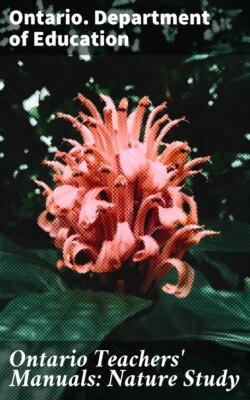Читать книгу Ontario Teachers' Manuals: Nature Study - Ontario. Department of Education - Страница 37
На сайте Литреса книга снята с продажи.
SHORT EXCURSIONS
ОглавлениеThe excursion need not occupy much time. It should be well planned beforehand. One object only should be kept in view and announced to the class before starting. Matters foreign or subordinate to this should be neglected for the time. The following are suggested as objects for excursions:
Objects.—A bird's nest in an adjacent meadow; a ground-hog's hole; a musk-rat's home; crayfish or clams in the stream near by; a pine (or other) tree; a toad's day-resort; the soil of a field; the pests of a neighbouring orchard; a stone-heap or quarry; ants' nests or earthworms' holes; the weeds of the school yard; buds; the vegetable or animal life of a pond; sounds of spring; tracks in the snow; a spider's web.
Such excursions may be accomplished at the expenditure of very little time. Many of them will take the pupils no farther than the boundaries of the school yard.
Of course the locality will influence the character of the excursion, as it will that of the whole of the work done in Nature Study, but in any place the thoughtful teacher may find material for open-air work at his very door.
Much outside work can be done without interfering with the regular programme. The teacher may arrange a systematic list of questions and problems for the pupils to solve from their own observations, and these observations may be made by the pupils at play hours, or while coming or going from school, or on Saturdays. The following will serve as an example of the treatment that may be followed:
Pests of Apple Trees.—Look on the twigs of your apple trees for little scales. Bring an infected branch to school. Note whether unhealthy-looking or dead branches are infected. Examine scales with a lens. Loosen one, turn it over, and examine with a lens the under side.
For eggs, look closely at the twigs in June. Do you see white specks moving? If so examine them with a lens.
Are there any small, prematurely ripe apples on the ground in the orchard? Cut into one of these and look for a "worm". Look for apples with worm holes in the side. Are there worms in these apples? What is in them? Note the dirty marks that the larva has left. Keep several apples in a close box and watch for the "worms" to come out. Examine the bark of apple trees for pupæ in the fall.
